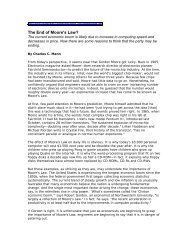计 算 机 组 织 与 系 统 结 构
æå°ç - å京大å¦å¾®å¤çå¨ç 究å¼åä¸å¿
æå°ç - å京大å¦å¾®å¤çå¨ç 究å¼åä¸å¿
- No tags were found...
Create successful ePaper yourself
Turn your PDF publications into a flip-book with our unique Google optimized e-Paper software.
Using Index Registers<br />
C i ← A i + B i , 1 ≤ i ≤ n<br />
LOADi -n, IX<br />
LOOP JZi DONE, IX<br />
A<br />
LOAD<br />
LASTA, IX<br />
ADD LASTB, IX<br />
STORE LASTC, IX<br />
JUMP<br />
LOOP<br />
LASTA<br />
DONE HALT<br />
• Program does not modify itself<br />
• Efficiency i has improved dramatically (ops / iter)<br />
with index regs without index regs<br />
instruction fetch 5(2)<br />
17 (14)<br />
operand fetch 2<br />
10 (8)<br />
store 1<br />
5 (4)<br />
• Costs:<br />
Instructions are 1 to 2 bits longer<br />
Index registers with ALU-like circuitry<br />
Complex control<br />
北 京 大 学 <strong>计</strong> <strong>算</strong> <strong>机</strong> 科 学 技 术 <strong>系</strong><br />
北 京 大 学 微 处 理 器 研 究 开 发 中 心<br />
Operations on Index Registers<br />
To increment index register by k<br />
AC ← (IX)<br />
AC ← (AC) + k<br />
IX ← (AC)<br />
new instruction<br />
new instruction<br />
also the AC must be saved and restored.<br />
It may be better to increment IX directly<br />
INCi k, IX IX ← (IX) + k<br />
More instructions to manipulate index register<br />
STOREi x, IX M[x] ← (IX) (extended to fit a word)<br />
...<br />
IX begins to look like an accumulator<br />
⇒ several index registers<br />
several accumulators<br />
⇒ General Purpose Registers<br />
北 京 大 学 <strong>计</strong> <strong>算</strong> <strong>机</strong> 科 学 技 术 <strong>系</strong><br />
北 京 大 学 微 处 理 器 研 究 开 发 中 心<br />
Evolution of Addressing Modes<br />
1. Single accumulator, absolute address<br />
LOAD<br />
x<br />
2. Single accumulator, index registers<br />
LOAD x, IX<br />
3. Indirection<br />
LOAD (x)<br />
4. Multiple accumulators, index registers, indirection<br />
LOAD<br />
R, IX, x<br />
or LOAD R, IX, (x) the meaning?<br />
R ← M[M[x] + (IX)]<br />
or R ← M[M[x + (IX)]]<br />
5. Indirect through registers<br />
LOAD R I , (R J )<br />
6. The works<br />
LOAD R I , R J , (R K ) R J = index, R K = base addr<br />
Variety of Instruction Formats<br />
Two address formats: the destination is same as one of the operand<br />
sources<br />
(Reg × Reg) to Reg R I ← (R I ) + (R J )<br />
(Reg × Mem) to Reg R I ← (R I ) + M[x]<br />
x can be specified directly or via a register<br />
effective address calculation for x could include indexing,<br />
indirection, ...<br />
Three address formats: One destination and up to two operand<br />
sources per instruction<br />
(Reg x Reg) to Reg R I ← (R J ) + (R K )<br />
(Reg x Mem) to Reg<br />
R I ← (R J ) + M[x]<br />
北 京 大 学 <strong>计</strong> <strong>算</strong> <strong>机</strong> 科 学 技 术 <strong>系</strong><br />
北 京 大 学 微 处 理 器 研 究 开 发 中 心<br />
北 京 大 学 <strong>计</strong> <strong>算</strong> <strong>机</strong> 科 学 技 术 <strong>系</strong><br />
北 京 大 学 微 处 理 器 研 究 开 发 中 心













